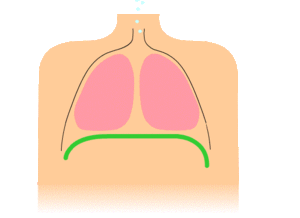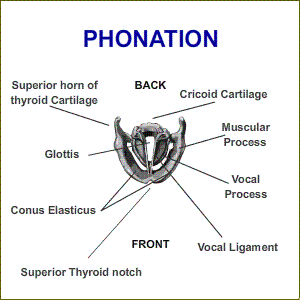
THE MECHANISM
UNDERSTANDING THE INSTRUMENT
- CONTENT
- The Acoustics of sound
- The Physical Elements
- The Resonators
- Placement
- Breathing

UNDERSTANDING THE INSTRUMENT
The musical sound has five essential properties: The pitch, the duration, the intensity, the color and sonance. These aspects are all measurable; and as such, can be studied scientifically.
The pitch is the aspect that is most discussed. The speed of the sound waves leaving the source of that sound is equal to the frequency at witch they are perceived by the inner ear. For example, when a musical instrument is tuned to the pitch of what is called Concert A, the frequency of this pitch or speed of the vibration is at 440 vibrations per second. Pythagore, the famous mathematician discovered that if you double this speed of vibration, the pitch would be exactly one octave higher and if you slowed it by half, an octave below. The lowest vibration recognized by the human ear is of 15 or 16 vibrations per second. And, at its highest speed, reaches 20,000 vibrations per second. Many animals and insects have the capacity of perceiving much greater or lower speeds. Beyond these we find the ultrasounds.
The duration of sound is the quality of sound most often taken for granted. Its description is quite simple: without a discriminative sense of the duration of a sound, it is impossible to determine the rhythm. This aspect is sometimes called syncopation.
The intensity. The intensity refers to the extent to which equilibrium is disturbed by the sound. How much were the molecules compressed? How far was the ear drum indented? How loud was the tone? So this is about the volume of the sound. This addresses directly the intensity or amplitude. In the case of the volume, subjective factors enter into play. If we turn up the intensity, we increase the volume. While producing a soft or quiet sound, the efficiency of the vocal instrument is reduced. Pour attain the desirable quality of sound, a greater efficacy and knowledge of the instrument is needed.
The color is perhaps the most difficult property of tone to explain. Synonyms are quality and tone-color. Even if all the instruments of the orchestra play the same note, the color of each is very different. The differences lie in the timbre and also the sonance.
The human voice produces sound waves that are in sympathetic vibration with many areas of the body, which means that other frequencies are awakened and merge to create the unique signature tone or timbre of that voice.
Sonancei another property of sound. Some theorists do not count it, but there are ideas involved in the concept of sonance which are important. At any given instant, sonance is not present, but when we listen to toe over a period of time we hear fluctuations of intensity, timbre, even pitch, and these changes form a pattern to which the term sonance is applied. In other words, if a tone has duration, it will have sonance. This is a borderline concept, because it involves various noises that are mixed with tone. Theoretically a noise is not a tone, and therefore sonance is not strictly a property of tone, but we cannot afford such precious distinctions. The singer makes sounds (like “v” and “z” for example) that are part tone and part noise.Resonance. Here we are getting to the most commonly used expression, most often wrongly used to describe the quality of a timbre. If we like the sound of a voice, we would say: It is a rich and resonant voice meaning to express that we find that the sound has a rich tone. We add resonance when we speak of improving the quality that is most often associated to brightness and clarity of the voice. We could also mean depth and richness of the sound but that would be completely to the opposite of resonance.
For a physician, resonance is the relationship between two vibrating bodies on a same pitch. When on body causes the harmonic vibration of another vibrating body, the phenomenon is called resonance. There are two types of resonance, sympathetic and forced. The resonance we find in the instrument of the voice is of the second type.

Breath support is, of course, the cornerstone of the singing voice. Air correctly contained within the lower part of the lungs is the key to stable and rich sound, while the diaphragm is the tool we use to get it there.
The diaphragm is a large muscle system separating the thorax from the abdomen, located directly below the lungs. Dome shaped, it is tied to the sternum and all around the inner walls of the rib cage reaching to the spine. It seals the lungs from the gut. Although we may not touch it, we can feel its motion.
The physiological role of the diaphragm lies within pulmonary ventilation, coughing, evacuation, giving birth and even laughing. Within the breathing muscles, it is the most significant in size and importance. Its contraction, by creating a depression within the thoraxic cavity, allows air to enter the airways. Inversely, its release from the contracted state creates the expiration or expulsion of air either in a passive or forced manner.
The larynx, commonly called voice box, is the organ of phonation made of cartilage and situated in the neck between the trachea and pharynx. The trachea is a cartilage-rimmed tube which allows oxygenated air to pass through to the lungs and carbon dioxide to be released from the lungs. The pharynx is an opening located above the larynx, in the back of the throat.
The larynx contains the true vocal cords along with the false cords located just above.
The larynx or voice box pivots back and forth creating a very slight extension or shortening of the vocal cords. Along with faster or slower vibrations, this creates higher or lower pitches. This is why an inexperienced singer feels a slight choking in the throat when he/she sings low pitches and a stretching sensation when he/she produces very high pitches.
 Commonly called Vocal Cords, the Vocal Folds are ligaments found inside the Larynx, from front to back. According to the Bernoulli Effect, named after Mr. Bernoulli who discovered this phenomenon during the 60s, the vocal folds are sucked together as air passes through the larynx creating a resistance or vibration that then becomes sound when resonating against the walls of mouth, throat, head, etc.
Commonly called Vocal Cords, the Vocal Folds are ligaments found inside the Larynx, from front to back. According to the Bernoulli Effect, named after Mr. Bernoulli who discovered this phenomenon during the 60s, the vocal folds are sucked together as air passes through the larynx creating a resistance or vibration that then becomes sound when resonating against the walls of mouth, throat, head, etc.
Although seemingly fragile, our Vocal Folds are quite resistant even though we may abuse them by shouting or screaming. Screaming for a few minutes is rather harmless but screaming while singing for an entire evening is quite another story. The Folds become swollen, making it impossible for them to vibrate.
This is what is called losing the voice. When singers regularly lose their voice, small sores (nodules) are created on the Vocal Folds which must later be surgically removed.
From a physiological point of view, the folds measure approximately 9 to 13 mm in women and 15 to 20 mm in men.
The most important muscle in breathing is, of course, the diaphragm which we talked about earlier.
Another group of muscles that also play an important role are the intercostals which are situated between the ribs. The diaphragm, the intercostals and a neck muscle called scalene come into play during air intake. If the expansion of the lungs requires additional help, other muscles of the neck and shoulders are recruited to help. Breathing that solicits neck and shoulder muscles is the least efficient. We will address this issue later.
The lower abs are also solicited to keep the rib cage open and wide to hold the diaphragm in its lower position and the air deep in the lungs.
The shoulder muscles must remain tension free at all times to allow the voice box to pivot.
The constrictor muscle is a cervical muscle situated behind the pharynx, at the base of the skull. It is divided into 3 distinct parts: upper, middle and lower. When the upper part contracts, it aids the mouth cavity move towards the esophagus and in chewing and swallowing food. The middle and lower parts, tied to the larynx, are instrumental in the pivoting of the voice box.
For singers, this region must remain completely tension free.

Sitting on The Breath is probably the most famous expression ever used to help visualize Tone Support. In other words, air becoming sound. The sound feels like it is sitting on the air. It is NOT being projected out of the body with the air. This sensation of air transformed into sound and suspended in the body is what we seek to understand, observe, experience and finally master.
For proper Tone Support, the air contained in the lungs must remain under pressure, away from the voice box, stable and free, not stiff or constricted. This is obtained with the diaphragm being held in its full-breath position, creating a downward suction and a sensation of pressurization. Although we cannot control the diaphragm directly, by soliciting the lower abs, keeping the coastal ribs wide and chest high, we can encourage it to remain down, in its full-breath position.
Pushing sound out damages the vocal folds because of too much pressure. The angle of the voice box and the speed of the fold vibrations happen naturally, beyond our control. The pitch we produce is actually a thought -- think about that for a minute! Our only job is to have the breath under control, to observe and to let everything happen naturally.
Another major challenge is keeping neck, shoulders, jaw and constrictor muscles tension-free while holding the ribcage wide and chest high. This is quite possible for anyone passionate and fascinated with this amazing instrument. It's all about understanding, observing, experiencing and finally mastering this technique with appropriate vocal and physical exercises.
The Glottis is the space between the vocal folds. Manuel Garcia advocated the Coup de Glotte and described it as a plosive, comparing it to the consonant [p]. However he also said: "It is very necessary to guard against confusing the articulation or stroke of the glottis with the stroke of the chest which resembles a cough, or the effort that one makes to expel from the gullet something that disturbs it."
There are two ways to initiate sound: first, in an explosive manner as in coughing, and as described by Garcia. Today, we call this Glottal Attack which is caracterized by raspiness or harshness. It causes a significant pressure in the larynx, surrounding muscles and vocal folds. Although the sound is initiated, its resonance, volume and color become impossible to manage.
The second way is the "imaginary h" or "imaginary aspirate". It creates distance between the air pressure and the vocal folds. The sensation is one of openness and tone support on the diaphragm. As in laughing, the sound is clear and resonant, allowing flexibility, color and strength.
A perfectly executed staccato is the ideal vocal exercise to develop the reflex of producing sound correctly. So, cough or laugh and experience the difference for yourself.
 We usually refer to a resonant voice as one that is loud. More importantly, a resonant voice refers to its color or timbre, its unique signature. A strong and beautiful voice is an indication that the resonators are opened, relaxed and vibrant.
We usually refer to a resonant voice as one that is loud. More importantly, a resonant voice refers to its color or timbre, its unique signature. A strong and beautiful voice is an indication that the resonators are opened, relaxed and vibrant.
There are 3 areas where the vibrations created by the vocal folds come alive: Head, Mask and Chest. Although these areas are in constant resonance, in order to observe, understand and awaken them, we need to isolate each one separately. Finally, when these 3 areas are fully resonating, all that is needed is to relax and allow them to work together. Unique to the shape and fabric of each body, the resonators are the building blocks of a beautiful voice.
The Head Resonator, as its name indicates, refers to the space at the back of the throat. Starting at the soft palate, it includes the back of the mouth cavity and extends beyond, into the imaginary space inside the head. This space, of a bell-tone quality, is awakened by high frequencies. We often hear the expression Head Voice when referring to high pitches. Although in varying percentage, the Head Resonator is always vibrant throughout the complete vocal range.
The Mask Resonator, the area where the words are formed, is made up of the face, hard palate, eyes, mouth, teeth, tongue and lips. This area, associated to the mid-tones, gives an edge and a beautiful vibrant crystalline quality to the voice. The Mask is where a singer feels the most vulnerable because that is where he shows himself, where he expresses emotion.

The Chest Resonator, associated to the lower tones, is located in the chest area, the seat of the sound. It is an area that resonates by sympathetic vibration. We cannot sing "IN" it because it is located under the voice box. It must be activated and resonant for a voice to have its complete color and be well supported. To explore it, we need to observe and work diligently.
It must be said: "There is no such thing as singing in Head Voice, Mask Voice or Chest Voice". All 3 resonating areas must be vibrant for a voice to be complete. Like the painter with his palette, the singer needs all his colors to complete his vocal tableau.
The Placement, or "La pause de la voix," is where the sound is ignited. Think of it as the spark that lights the match, or turns on the light bulb. Even though the actual vibrations are created by the vocal folds, the placement is where the sound is sparked. It literally feels like it appears there. There are two types of placements: Classical and Forward.

Classical Placement focuses sound at the highest point of the hard palate where it merges with the soft palate. The soft palate is lifted as in initiating a yawn, offering a solid sounding board to the tone. This placement is fixed; in other words, it does not move throughout the entire range.
In Forward Placement, the focus is at the lips, teeth and mouth, moving up along the hard palate as the pitch gets higher. As the pitch moves down, the placement remains at the lips and teeth while the chest resonator activates. As we know, we cannot sing under the voice box to produce lower tones.
The Speaking Voice Placement is very important to good vocal production. It is essential to any singer or speaker that wishes to maintain a healthy and strong voice. The placement is forward and never FALLS BACK into the throat which causes the cracking of the sound, putting too much pressure on the vocal cords. The sound should always remain in the mouth, above the throat, in an open space where lips, teeth and tongue play a major role in pronunciation.
 Breath Control is the aspect of tone support, we must fully understand in order to grasp the importance of a correct breathing technique for singing. First, the air must be placed deep into the lungs, and remain stable while under pressure. To attain this, we trigger the diaphragm to do what it does naturally, even though it is a muscle we cannot control...
Breath Control is the aspect of tone support, we must fully understand in order to grasp the importance of a correct breathing technique for singing. First, the air must be placed deep into the lungs, and remain stable while under pressure. To attain this, we trigger the diaphragm to do what it does naturally, even though it is a muscle we cannot control...
For example, if you fill a balloon with air and keep the spout open, the air will escape due to the pressure applied to its walls. During vocal production, the air must remain under pressure, away from the larynx and the vocal cords, while the throat is open and tension free. This air is stabilized by the diaphragm as it remains in it's contracted state.
With this in mind, let us explore the 5 breathing techniques as described by William Vennard and see which is best, and which one you use.

Shoulder Breathing is the least effective technique for good tone support. When running, stressed or afraid, shoulder breathing occurs.
We have all felt it: air is pulled in, held high in the upper lungs under the shoulders and rushes out as soon as the shoulders fall. Air flow is then very difficult to control and so are the tone, volume, pitch, etc. of the singing or speaking voice.
In order to hold the air in, singers contract shoulder, neck, and upper back muscles. However, this tightness hinders the movement of the larynx and limits the many parameters of proper vocalization.
With shoulder breathing, the air is held very high and this direct pressure under the vocal folds causes an explosive attack that may damage them. The air MUST sit in the lower part of the lungs, far from the larynx for perfect breath control and tone support.

Belly Breathing is the second least efficient breathing technique for singers. While it is efficiently used in yoga and other disciplines for relaxation, it is not at all effective in tone support.
Air pressure is impossible to attain or maintain when the abdominal wall is released because, in order to trigger the diaphragm and keep it contracted, we need muscle coordination. Releasing the abdominal wall takes away from that muscle coordination while we exert unnecessary energy.
Look closer: there are no lungs in the belly!

Jumping of the Epigastrium is a much better technique for breath control, and is included in the coastal breathing technique. It offers a clear physical indication that the air as reached the bottom of the lung.
It is felt as a buldging of the muscle called epigastrium, just below the sternum. When the diaphragm sucks in air, it flattens downward, pushing viscera forward out of the way. This was the first breathing technique I learned in Vancouver way back in 1969...
Although it is efficient, on its own, it lacks the width and fullness we are looking for. The Jumping of the Epigastrim is a great way to diagnose if the diaphragm comes into action.
Try this: stand, place the tips of your fingers under the sternum, then produce a clear tone while applying a little bouncing action. Observe the change in sound. Tell your brain that this is where the air should come. When you are at the end of the sound, apply a little pressure with the fingers, engage the lower abs and let the air in. Observe what happens... Did the air rushing in, push your fingers out? If there is no movement, it's that the diaphragm did not contract downward to pull in the air. Try it again, experiment, have fun!

Inter Costal or Diaphragmatic Breathing is the most efficient breathing technique for singers. As we empty the air completely, the Diaphragm rises to reach it's maximal upward extension. The greater the need for air, the faster and most efficiently it will snap back just like an elastic band, and suck the air deep into the lungs. All we need to do is LET GO, make room in the lower lung area, and observe.
While it sounds simple, it is not. The diaphragm cannot be controled. It is a knee-jerk reaction muscle so to trigger it to pull the air in, can be frustrating. To experience this action, try coughing or laugh. Do you feel how the belt area aroung the lower ribs is activated? It includes the Jumping of the Epigastrium technique.
Our job is to hold the air in place while relaxing all neck, shoulder and back muscles. The only way to do this is first, a proper posture, then engage the lower abs. The pelvic floor is slightly tilted to solicit the musles that will stabilise the core. At first, it is difficult because our instinct is to be relaxed around the abs and tighten at the shoulders. We are turning this around, relaxed at the shoulders and engaged at the lower abs and pelvic floor area. All this happens quite invisibly after it is mastered so, do not worry, once you get it, it's fantastic!

Back Breathing, a natural extension of inter costal breathing, and an image we use to visualise that suplus of air taken in by the contraction of the diaphragm, being tucked back. It sits on what we can visualise, as a platter including the diaphragm while extending behind the coastal ribs. The sensation is one of sitting the air down with a feeling of fullness and abundance.
William Vennard debates the existance of this breathing technique but, as it is an extension of inter costal breathing, it is not in itself considered a stand alone technique.
If I may permit myself a personnal comment, when we have lots of air that rushes in, the comfort of that image of opening the back, allows us to sit the air down more easily rather that feeling it should fill the space in the upper lung. It works for me!

I would love to hear from you and get your thoughts, comments and feedback about this website as well as any questions you may have.
Email me at :
Phone : (514) 817-5838
Website: Johanne Desforges